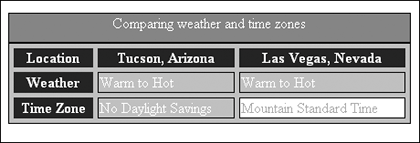Class selectors are custom selectors that you give a name to; you precede that name with a dot, as in .classname. Classes are then applied to an element in the HTML using the class attribute, with a value of the class name:
<tr class="classname"> . . . </tr>
Typically, you'll want to describe the function of the class rather than the presentation. So, if you're going to apply a background color to every other table row, you'll want to name your class something like .alternaterow instead of .gray. This way, if you want to change the color, you needn't change the class name throughout your documents, which defeats the management advantages of CSS.
Example 8.4 shows a modified table you first worked with in tutorial 4, "Creating Tables." You'll note that I made one change in the table markup: I took out all the table attributes except for cellspacing. This is because there is no effective means of providing cellspacing in CSS.
I've also added an embedded style sheet that includes the table width, border, and padding styles, along with element selectors and a class selector to style the table using background colors in the elements.
Example 8-4. Styling the table with element and class selectors
<!DOCTYPE html PUBLIC "-//W3C//DTD XHTML 1.0 Transitional//EN"
"http://www.w3.org/TR/xhtml1/DTD/xhtml1-transitional.dtd">
<html xmlns="http://www.w3.org/1999/xhtml">
<head>
<title>working with style</title>
<style type="text/css">
body {color: white;}
caption {background-color: #999; border: 1px solid black;}
table {background-color: #ccc; border: 1px solid black; padding: 5px; width: 90%;}
th {background-color: #333; border:}
tr {background-color: #999;}
td {background-color: #ccc; border: 1px solid black;}
.highlight {background-color: #fff; color: orange;}
</style>
</head>
<body>
<table cellspacing="5">
<caption>Comparing weather and time zones</caption>
<tr>
<th>Location</th>
<th>Tucson, Arizona</th>
<th>Las Vegas, Nevada</th>
</tr>
<tr>
<th>Weather</th>
<td>Warm to Hot</td>
<td>Warm to Hot</td>
</tr>
<tr>
<th>Time Zone</th>
<td>No Daylight Savings</td>
<td class="highlight">Mountain Standard Time</td>
</tr>
</table>
</body>
</html>
Figure 8-5 shows the results.
Figure 8-5. Styling a table with element and class selectors.

NOTE
You'll also notice I added borders to spice things up a bit. You can learn more about styling borders in tutorial 11, "Margins, Borders, and Padding."
As you are beginning to find out, you can do a lot with CSS to enhance your documents. Here we've turned a plain-vanilla table into something with a little style.